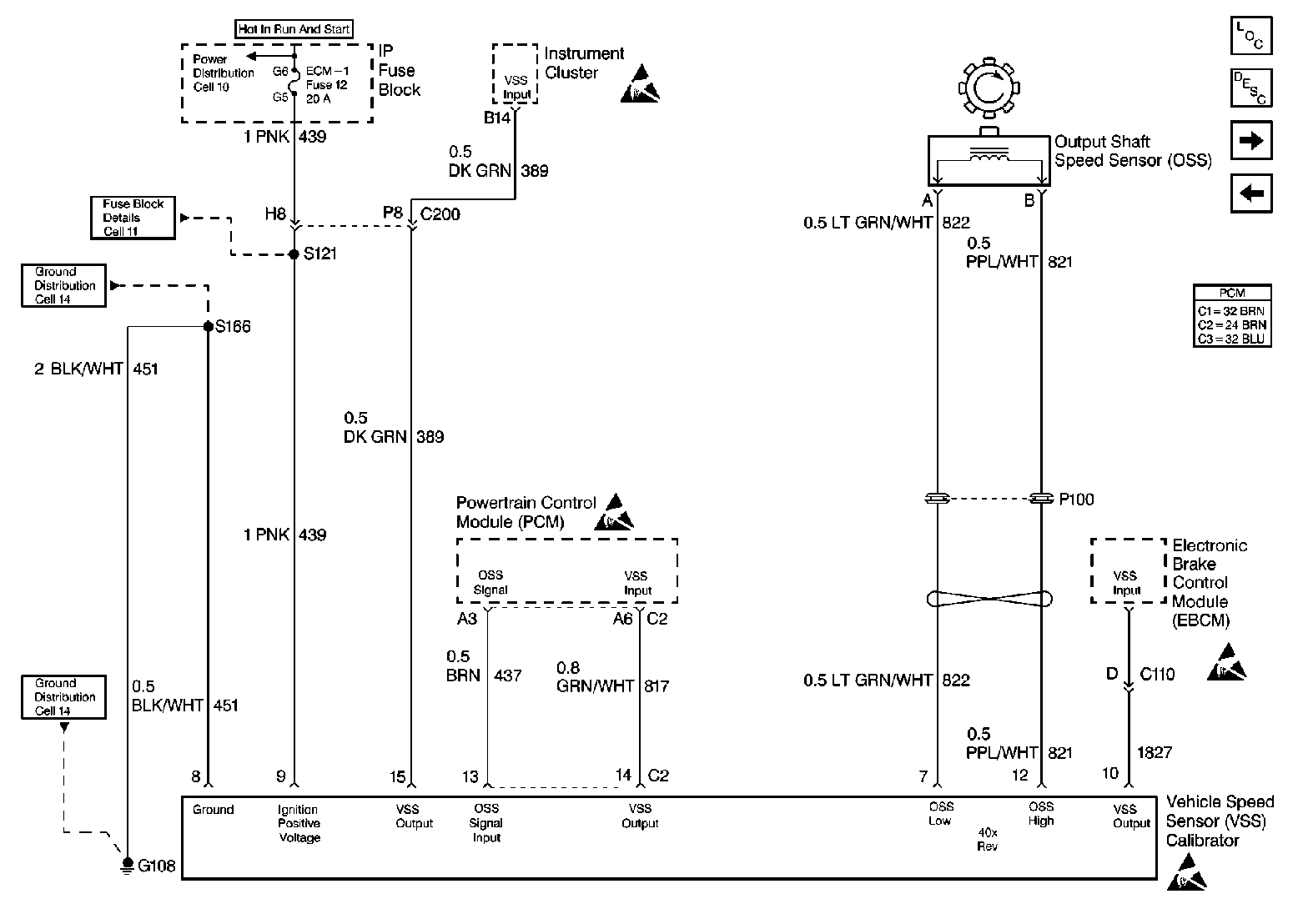Refer to
Engine Controls (Cell 22: Engine Data Sensors)

.
Circuit Description
The speed sensor circuit consists of a magnetic induction type sensor, a vehicle speed sensor buffer module and wiring. The gear teeth pressed on the output shaft induces an alternating current in the sensor. This signal is transmitted to the buffer. The buffer compensates for various axle ratios and converts the signal into a square wave for use by the speedometer, the cruise control, the antilock brake and the PCM. The buffer sends two different signals to the PCM.
Conditions for Setting the DTC
| • | The vehicle speed is greater than 20 mph. |
| • | The four wheel low is not selected. |
| • | The VSS buffer calculated speed is less than half of the transmission calculated speed. |
or
| • | The VSS buffer calculated speed is greater than the transmission calculated speed by 20 mph. |
| • | All of the conditions must be met for 2 seconds. |
Action Taken When the DTC Sets
| • | The PCM will not illuminate the Malfunction Indicator Lamp (MIL). |
| • | The PCM records the operating conditions at the time the diagnostic fails. This information stores in the Failure Records. |
Conditions for Clearing the MIL/DTC
| • | A History DTC will clear after forty consecutive warm-up cycles during which the diagnostic does not fail (the coolant temperature has risen 5°C (40°F) from the start up coolant temperature and the engine coolant temperature exceeds 71°C (160°F) during that same ignition cycle). |
| • | Use of a Scan tool will clear the DTC codes. |
Diagnostic Aids
Check the connections at the VSS buffer and the PCM. Refer to Diagnostic Trouble Codes in Automatic Transmission - 4L80E if DTC P0722 or DTC P0723 is also set.
Test Description
The numbers below refer to numbers on the Diagnostic Table.
-
This tests for B+ at the VSS buffer.
-
This tests for a proper ground path for the vehicle speed sensor signal buffer.
Step | Action | Value(s) | Yes | No |
|---|---|---|---|---|
1 |
Important: Before clearing any DTCs, use the Scan Tool Capture Info to save freeze frame and failure records for reference, as the Scan Tool loses data when using the Clear Info function. Was the Powertrain On-Board Diagnostic (OBD) System Check performed? | -- | Go to A Powertrain On Board Diagnostic (OBD) System Check | |
2 |
With the drive wheels rotating, does the vehicle speed increase with the drive wheel speed increase? | -- | ||
Is the test light ON? | -- | |||
Back probe the VSS buffer module ignition feed circuit to the ground circuit with a test light. Is the test light ON? | -- | |||
5 |
Does the voltage increase on J 39200 with the drive wheel increase? | -- | ||
6 | Does the Scan Tool display a trans output speed (MPH) increase with the drive wheel increase? | -- | ||
7 | The DTC is intermittent. If no additional DTCs are stored, refer to Diagnostic Aids. If any additional DTCs are stored, refer to those tables first. Are there any additional DTCs stored? | -- | Go to the applicable DTC table | Go to Diagnostic Aids |
8 | Repair the open in the ignition feed circuit. Is the action complete? | -- | -- | |
9 | Repair the open in the ground circuit. Is the action complete? | -- | -- | |
10 |
Was a repair performed? | -- | ||
11 |
Was a problem found? | -- | ||
12 |
Is there voltage present? | -- | ||
13 | Check the VSS output circuit for an open or short to ground. Was a repair performed? | -- | ||
14 | Check the VSS output circuit for a poor connection at the buffer module and the PCM. Was a repair performed? | -- | ||
15 | Replace the Vehicle Speed Sensor. Refer to Vehicle Speed Sensor in Manual Transmission. Is the action complete? | -- | -- | |
16 | Replace the VSS Buffer module. Refer to Vehicle Speed Signal Buffer Replacement . Is the action complete? | -- | -- | |
17 | Replace the PCM. Important: The new PCM must be programmed. Refer to PCM Replacement/Programming . Is the action complete? | -- | -- | |
18 |
Does the Scan Tool indicate the diagnostic Passed? | -- | ||
19 | Does the Scan Tool display any additional undiagnosed DTCs? | -- | Go to the applicable DTC table | System OK |
